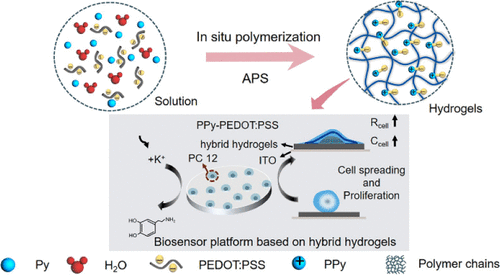当前位置:
X-MOL 学术
›
ACS Appl. Mater. Interfaces
›
论文详情
Our official English website, www.x-mol.net, welcomes your
feedback! (Note: you will need to create a separate account there.)
Highly Conductive PPy–PEDOT:PSS Hybrid Hydrogel with Superior Biocompatibility for Bioelectronics Application
ACS Applied Materials & Interfaces ( IF 8.3 ) Pub Date : 2021-05-19 , DOI: 10.1021/acsami.1c04432 Xiaoning Ren 1 , Ming Yang 1 , Taotao Yang 1 , Chao Xu 1 , Yongqin Ye 2 , Xiongni Wu 1 , Xing Zheng 1 , Bin Wang 2 , Ying Wan 1 , Zhiqiang Luo 1
ACS Applied Materials & Interfaces ( IF 8.3 ) Pub Date : 2021-05-19 , DOI: 10.1021/acsami.1c04432 Xiaoning Ren 1 , Ming Yang 1 , Taotao Yang 1 , Chao Xu 1 , Yongqin Ye 2 , Xiongni Wu 1 , Xing Zheng 1 , Bin Wang 2 , Ying Wan 1 , Zhiqiang Luo 1
Affiliation

|
Conductive polymer hydrogels (CPHs) hold significant promise in broad applications, such as bioelectronics and energy devices. Hitherto, the development of a facile and scalable synthesis method for CPHs with high electrical conductivity and biocompatibility has still been a challenge. Herein, we demonstrate highly conductive PPy–PEDOT:PSS hybrid hydrogels which are prepared by a simple solution-mixing method. This fabrication method involves the mixing of a pyrrole monomer with a PEDOT:PSS dispersion, followed by in situ chemical oxidative polymerization to form polypyrrole (PPy). The electrostatic interaction between negatively charged PSS and positively charged conjugated PPy facilitates the formation of PPy–PEDOT:PSS hybrid hydrogels. The conductivity of the PPy–PEDOT:PSS hybrid hydrogels is 867 S m–1. The PPy–PEDOT:PSS hybrid hydrogels show excellent biocompatibility. Moreover, the PPy–PEDOT:PSS hybrid hydrogels have a hierarchical porous structure which facilitates the 3D cell culture within the hydrogels. The PPy–PEDOT:PSS hybrid hydrogels exhibit excellent in situ biomolecular detection and real-time cell proliferation monitoring performance, indicating their potential as highly sensitive electrochemical biosensors for bioelectronics applications. Our strategy for the fabrication of CPHs with the electrostatic interaction between the negatively charged conductive polymer and positively charged conductive polymer would provide new opportunities for the design of highly conductive conjugated hydrogels for bioelectronics applications and energy devices.
中文翻译:

高导电性 PPy-PEDOT:PSS 混合水凝胶,具有用于生物电子学应用的卓越生物相容性
导电聚合物水凝胶 (CPH) 在广泛的应用中具有重要的前景,例如生物电子学和能源设备。迄今为止,开发具有高导电性和生物相容性的 CPH 的简便且可扩展的合成方法仍然是一个挑战。在此,我们展示了通过简单的溶液混合方法制备的高导电性 PPy-PEDOT:PSS 混合水凝胶。这种制造方法包括将吡咯单体与 PEDOT:PSS 分散体混合,然后进行原位化学氧化聚合以形成聚吡咯 (PPy)。带负电的 PSS 和带正电的共轭 PPy 之间的静电相互作用促进了 PPy-PEDOT:PSS 混合水凝胶的形成。PPy-PEDOT:PSS 混合水凝胶的电导率为 867 S m–1 . PPy-PEDOT:PSS 混合水凝胶显示出优异的生物相容性。此外,PPy-PEDOT:PSS 混合水凝胶具有分层多孔结构,有利于水凝胶内的 3D 细胞培养。PPy-PEDOT:PSS 混合水凝胶表现出优异的原位生物分子检测和实时细胞增殖监测性能,表明它们作为用于生物电子学应用的高灵敏度电化学生物传感器的潜力。我们通过带负电的导电聚合物和带正电的导电聚合物之间的静电相互作用来制造 CPH 的策略将为设计用于生物电子应用和能源设备的高导电性共轭水凝胶提供新的机会。
更新日期:2021-06-02
中文翻译:

高导电性 PPy-PEDOT:PSS 混合水凝胶,具有用于生物电子学应用的卓越生物相容性
导电聚合物水凝胶 (CPH) 在广泛的应用中具有重要的前景,例如生物电子学和能源设备。迄今为止,开发具有高导电性和生物相容性的 CPH 的简便且可扩展的合成方法仍然是一个挑战。在此,我们展示了通过简单的溶液混合方法制备的高导电性 PPy-PEDOT:PSS 混合水凝胶。这种制造方法包括将吡咯单体与 PEDOT:PSS 分散体混合,然后进行原位化学氧化聚合以形成聚吡咯 (PPy)。带负电的 PSS 和带正电的共轭 PPy 之间的静电相互作用促进了 PPy-PEDOT:PSS 混合水凝胶的形成。PPy-PEDOT:PSS 混合水凝胶的电导率为 867 S m–1 . PPy-PEDOT:PSS 混合水凝胶显示出优异的生物相容性。此外,PPy-PEDOT:PSS 混合水凝胶具有分层多孔结构,有利于水凝胶内的 3D 细胞培养。PPy-PEDOT:PSS 混合水凝胶表现出优异的原位生物分子检测和实时细胞增殖监测性能,表明它们作为用于生物电子学应用的高灵敏度电化学生物传感器的潜力。我们通过带负电的导电聚合物和带正电的导电聚合物之间的静电相互作用来制造 CPH 的策略将为设计用于生物电子应用和能源设备的高导电性共轭水凝胶提供新的机会。


















































 京公网安备 11010802027423号
京公网安备 11010802027423号